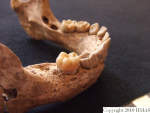1. OVERVIEW
| Roster | Date | Author | Record |
|---|---|---|---|
| Category | !! | !! | organic |
| Best definition | 2007-08-09 | !! | human body [Input: R809PC.j] |
| Best image | 2012-03-26 | lC |  [Input: W326LC.j] [Input: W326LC.j] |
2. IDENTIFICATION
Designation
| Roster | Date | Author | Record |
|---|---|---|---|
| Definition | 2007-08-09 | pC | human body [Input: R809PC.j] |
| Description (summary) | 2001-08-29 | lR | human remains found inside i71 appears to be of a small child. The bones were found scattered within and did not hold any shape. [Input: M917LR.j] |
| 2002-10-11 | lR | The human remains of a small child found inside jar i71. This body was found in poor condition and could not be articulated. The arm bone of this item has been removed and is included with i73 metal bracelet since the bone had solidified to the bracelet. Refer to a15 for objects associated with this burial. [Input: MX12LR4.j] | |
| 2007-08-18 | lR | i78 are the remains of a child buried inside a large ceramic jar recovered in the early Khabur levels at Mozan (1900 BCE). The funerary assemblage contained various artifacts including metal rings, jars, and beads representing the most elaborate burial in terms of artifacts present in A16. During the early Khabur, the practice of burying young children within ceramic jars or portions of jars appears commonplace however this practice appears to diminish during the later Khabur phase. Age estimate for this skeleton determined through dental development, diaphyseal long bone lengths, and stages of epiphyseal union visible on the skeleton. The deciduous molars and canines show incomplete root development with both deciduous mandibular molars in Rc development stage, deciduous mandibular canine at R ¾, and permanent mandibular molar 1 at Cr ¾- Crc. Using Moorrees, Fanning, and Hunt 1963, dental development was assessed between 1-2.8 years for both male and female profiles. Diaphyseal measurements of the humerus (130 mm) and fibula (135 mm) also suggest an age within 1.7-3.5 years (Hoppa 1992). Skeletal growth establishes this child between ages 1-3, fusion of the vertebral arches at midline and the lateral portion of the occipital bone unfused. Averaging the ranges for all the methods results in estimating A16. 78 within the age range of 1.5-2.5 years at the time of death. No pathological conditions were noted however several bones are discolored due to their proximity to oxidized metals. [Input: UZ15MM.j] |
3. STRATIGRAPHY
Recovery/Assignment
| Roster | Date | Author | Record |
|---|---|---|---|
| Daily notes about recovery of elements | 2001-08-31 | MISSING | Inside the jar i71 numerous items were found along with the body of a small child i78. The items includes two bronze bracelets i72, i73, 8 metal rings i74, 9 beads i75(one lapis bead shaped like a duck, one circular lapis bead, one red bread carved like a pair of eyes with white paint, and the rest quartz crystal beads), a metal pin i76, and a metal head piece i70. [Input: L831LR.j] |
Volumetric Localization
| Roster | Date | Author | Record |
|---|---|---|---|
| Locus | 2001-08-29 | lR | k110 [Input: M917LR.j] |
Contact Association
| Roster | Date | Author | Record |
|---|---|---|---|
| Type of contact: contemporary events/movable items | 2001-08-29 | lR | i78 (human body) sits in f227 (fill) [Input: M917LR.j] |
Spatial Aggregation
| Roster | Date | Author | Record |
|---|---|---|---|
| Aggregate (to which element belongs) | 2000-12-18 | !! | a15 (burial) [Input: A-CUMUL.j] |
| Nature of association | 2001-08-29 | lR | associated q-lot: 655 [Input: M917LR.j] |
Time Sequencing
| Roster | Date | Author | Record |
|---|---|---|---|
| Stratum (to which element belongs) | 2015-05-20 | !! | s330AAH [Input: ZA520CJC.j] |
| Phase (to which element belongs) | 2015-05-20 | !! | h5hAAH [Input: ZA520CJC.j] |
6. REFERENCE
Analogical Record
| Roster | Date | Author | Record |
|---|---|---|---|
| Photo of individual elements (studio) | |||
Disposition
| Roster | Date | Author | Record |
|---|---|---|---|
| Notes on disposition | 2002-10-11 | lR | to Natural science lab [Input: MX12LR4.j] |
Files and Publications
| Roster | Date | Author | Record |
|---|---|---|---|
| Project publications | 2025-03-07 | mDP | Kharobi 2014, p. 140. [Input: ZJ225_biblio_mDP.j] |






